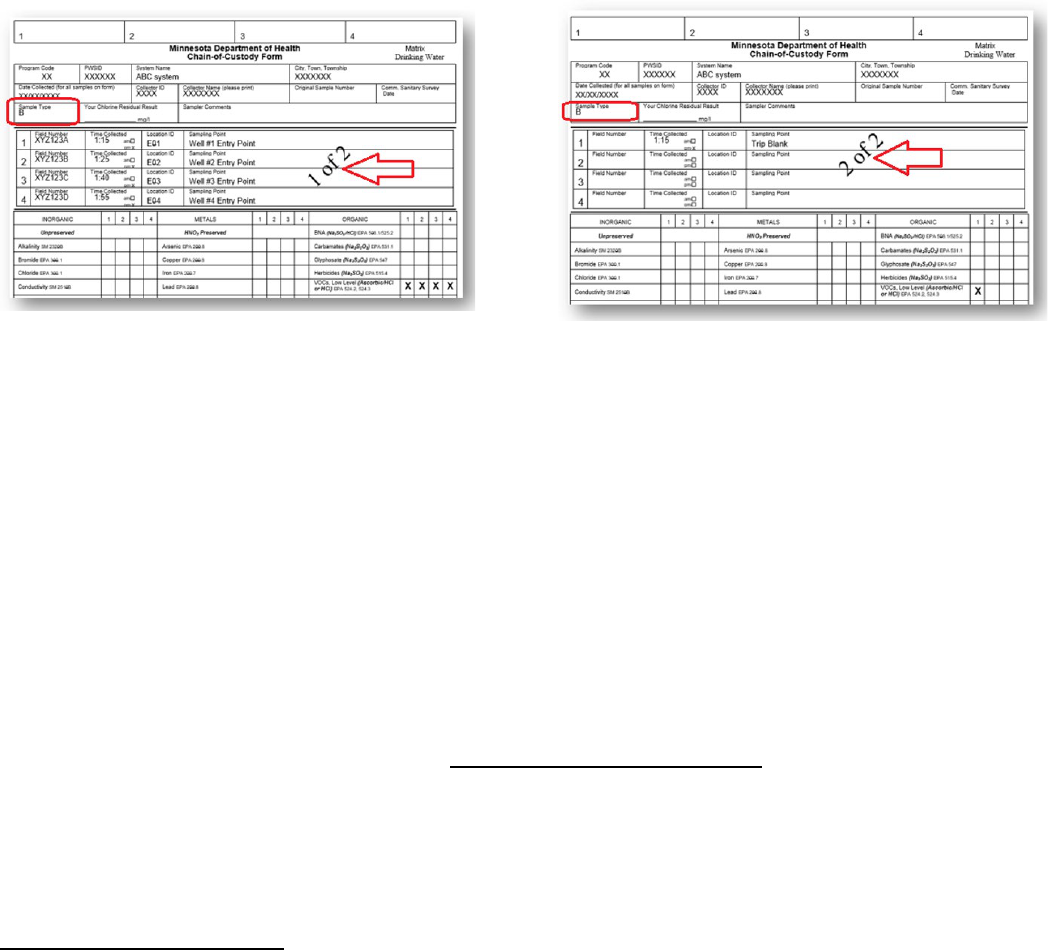
Trip Blanks
SAMPLE COLLECTION PROCEDURE
Pre-Collection Information
Trip blanks are required when the reference methods dictate it.
Currently, the following methods require the use of trip blanks (these will be referred to as “target analyte” in
this document):
Regulated volatile organic compounds (VOCs) analyzed by reference method EPA 524.3.
Ethylene dibromide (EDB) analyzed by reference method EPA 504.1.
The Public Health Laboratory (PHL) prepares the trip blanks.
Trip blanks must accompany the target analyte samples throughout the entire trip.
Do not open trip blanks in the field.
You must submit a set of trip blanks (number and container type can be found on the target analyte SCP) for each
chain of custody (COC) when a target analyte sample is collected.
If a trip blank forms a bubble that appears to be greater than 6 millimeters (mm) in diameter, dispose of it and use
another trip blank set.
Bottle Label Information
Trip blank bottle labels are pre-printed for each required set of target analyte samples.
If submitting only one COC per PWS, you do not need to write anything on the bottle, “Trip Blank” on the
Drinking Water Protection (DWP) pre-printed label serves as the unique identifier.
If you are submitting multiple sets of trip blanks for the same PWS (i.e., multiple COCs), you must write a
unique identifier on the trip blank bottle labels. This can be the time associated with the trip blanks or you can
assign the trip blanks a field number and write that on the trip blank bottle labels and COC(s).
If pre-printed DWP bottle labels are not available, you must write the PWS identification (PWSID) number, PWS
name, and the unique identifier on the trip blank bottle labels.
Chain of Custody (COC) Information
You must write “Trip Blank” on a line of the COC. You must mark the analysis required (i.e., VOC, EDB, etc.).
PHL uses this information to log the trip blank set into their database, track it throughout the lab, and analyze
it as a quality control sample.
Do not enter anything in the Location ID field.
Only one set of trip blanks is required per COC, regardless of the number of target analyte samples requested on
that COC.
You must write down a time for the trip blanks on the COC’s “Time Collected” field and the trip blank bottle labels.
The time should be the same time as the time the first target analyte is collected.
If you chose to use a field number as the unique identifier, you must write that on the COC and the trip blank
bottle labels.

TRIP BLANKS - SAMPLE COLLECTION PROCEDURE
2
Unique COC Examples
If a COC already has four sample points identified, the trip blanks must be documented on a second COC.
In this case it is necessary to mark the COCs “1 of 2” and “2 of 2” on the COCs.
Ship both COCs and containers in the same box to PHL.
The images below show examples. You can write across the Sample Point section or you can write in the Sampler
Comment section.
Post-Collection Information
If a target analyte sample arrives at PHL without a trip blank or with a trip blank that is canceled, the target analyte
sample will not be canceled. It will be analyzed and the data qualified if needed.
If multiple sets of trip blanks from the same PWS arrive in the same shipment and are not uniquely identified, all trip
blanks of the shipment will be canceled; samples will still be analyzed and qualified if needed.
If a trip blank is documented on the COC but no time is documented, PHL will contact compliance staff and request a
time. In these cases, the trip blank and the sample will not be canceled.
PWSs may see two data qualifiers (B6 and B7) associated with trip blanks on their final reports. If you receive
questions about these, please refer the PWS to the compliance officer for clarification on how the result is used for
compliance determination. Information about what the new data qualifiers mean:
B6: The analyte was found in both trip blank and sample.
B7: The result is suspect. It was not confirmed as a positive detection because there was no trip blank to
evaluate for possible contamination.
If you have questions, call 651-201-4700, or email health.drinkingwater@state.mn.us.
Minnesota Department of Health
Drinking Water Protection
651-201-4700
health.drinkingwater@state.mn.us
www.health.state.mn.us
March 2021
To obtain this information in a different format, call 651-201-4700.
